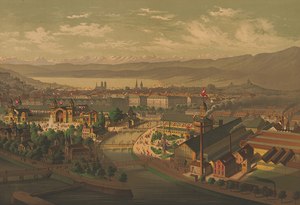
Unternavigation
Free Democratic Liberal Party
At the beginning of the 20th century, the representatives of the progressive wing of the Free Democratic Party (renamed FDP.The Liberals in 2009) were among the driving forces behind the introduction of the first social policies. The party advocated forms of social security that did not stand in opposition to private interests and free market principles.
The Free Democratic Party (FDP) was founded in 1894. It brought together the cantonal parties that stood for individual freedom and the promotion of a liberal economic system with as little state intervention as possible. However, left-wing liberals (as opposed to economic liberals) defended a significant amount of state intervention in the area of social security. The defence of individual freedom was thus combined with a concept of statehood according to which the state had to guarantee the protection of individuals and social cohesion.
The FDP dominated Parliament and the Federal Council since its victory in 1848 and up to the First World War. In 1919, due to the rise of the Social Democratic Party as well as the Farmers’, Burghers and Craftsmen Party (BGB), the FDP was prompted to strengthen its position through an alliance with the Catholic Conservative Party (CVP) and cede a second seat in the Federal Council to its allies. The introduction of proportional representation put an end to liberal dominance in the Federal Assembly and many cantonal governments and parliaments. Despite this, the FDP was able to retain a majority in the Federal Council until 1959. It was not until then that the social democrats gained a second seat, following their first Federal Council seat in 1943; this left the liberals with just two seats. The party’s shae of the vote amounted to 28 percent in the 1920s; it subsequently fluctuated between 20 and 24 percent of votes until the 1990s, before falling to 16 percent in 2007.
At the beginning of the 20th century, the Federal Council and Parliament – both dominated by liberals – supported the introduction of health insurance. After a constitutional article was adopted in 1890 which gave the Confederation the power to introduce a compulsory health and accident insurance, it was Ludwig Forrer a national councillor from the progressive wing of the FDP and future federal councillor who prepared the draft for mandatory state health and accident insurance. However, the Lex Forrer was rejected by referendum in 1900.
With respect to unemployment insurance, liberal parliamentarians were in favour of encouraging provision through subsidies in 1924 and hence voted for the first pertinent federal act. They advocated an insurance model that promoted secure working conditions, although policyholders had to assume a substantial share of the financingthemselves which served of the interests of employers.
By accepting the constitutional article for old age insurance, the conservative alliance (Bürgerblock) responded to social democratic demands. At the same time, this was an attempt to relieve social tensions that had arisen in the wake of the general strike of 1918. The proposal’s acceptance indicated that a portion of the Free Democrats were in favour of state intervention in social policy. In 1931, a firstmodest project for old age insurance drafted by FDP federal councillor Edmund Schulthess was rejected at the ballot box. Another liberal federal councillor, Walther Stampfli, advocated a new plan for old age and survivors’ insurance (AHV) in 1944. The AHV bill was accepted in 1947 and enabled bourgeois parties to introduce the principle of minimal social security without harming the interests of existing pension funds.
In the decades following the Second World War (1948–1990), the Free Democrats supported a certain degree of expansion and consolidation of the welfare state. This is apparent in the introduction of disability insurance (1960), supplementary AHV benefits (1966) and compulsory unemployment insurance (1976), though benefits were always set below what the left demanded. In the case of unemployment insurance, the Free Democrats advocated the retention of controls over the unemployed and hence pursued the interests of employers. The party also backed what became known as the three-pillar model and the development of occupational provision at the expense of an expanded AHV (1972).
The economic crisis of the 1970s (1975-1979) and the end of economic growth intensified critical rhetoric from all bourgeois parties with respect to social insurance. In 1979, the FDP campaigned with the slogan ‘More Freedom and Responsibility – Less State’ during national elections. The party’s criticism of a purportedly over-expanded welfare state particularly began to take root from the 1990s (1990-2010) and was accompanied by reforms that reduced benefits while increasing control of beneficiaries. Within the FDP, even the wing that had historically supported the welfare state backed these reforms. At the beginning of the 21st century, the liberal federal councillor from Valais, Pascal Couchepin, thus called for revisions seeking to reduce disability insurance pensions, a greater transfer of healthcare costs to policyholders and an increase to retirement age. Despite support for national maternity leave (2004), the Free Democratic Liberal Party was clearly committed to limiting social security.
Literatur / Bibliographie / Bibliografia / References: Meuwly Olivier (2010), Les partis politiques. Acteurs de l’histoire suisse, Lausanne; Couchepin Pascal (2002), Je crois à l’action politique, Entretien avec Jean Romain, Lausanne.
(12/2014)




